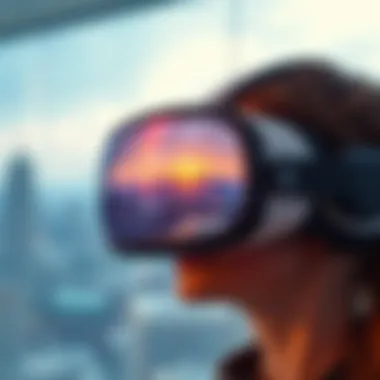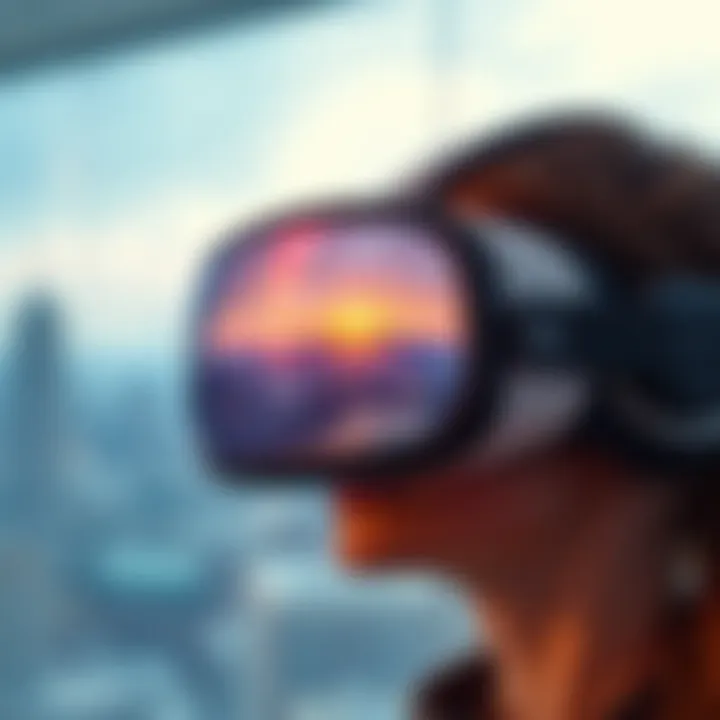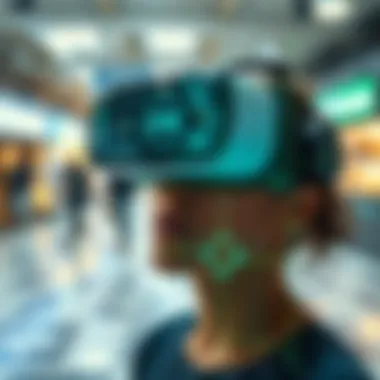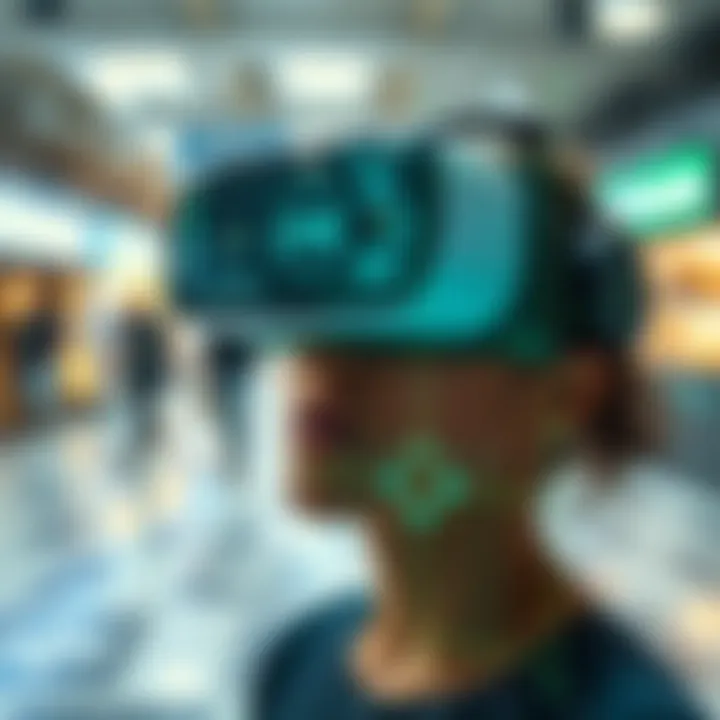Exploring VR and AR's Impact on Digital Innovation


Intro
In a world rapidly evolving with technological advancement, two players have taken center stage: Virtual Reality (VR) and Augmented Reality (AR). Once seen as mere novelties in the realm of gaming and entertainment, these immersive technologies are now reshaping industries from education to healthcare, and retail to real estate. The synergy between VR and AR allows for experiences that engage users on a deeply interactive level, merging the boundaries between what’s real and what’s digitally constructed.
Understanding the interplay of VR and AR is not simply an academic pursuit; it's a lens through which we can discern the next phases of digital innovation. Investors, analysts, entrepreneurs, and developers alike stand to gain from delving into how these technologies dynamically interact, influencing user engagement and setting the stage for future trends.
As we explore this transformative narrative, we’ll dissect not only the definitions and technological foundations of VR and AR but also their practical applications across diverse sectors. We will examine both the benefits and challenges these technologies bring to the table, all while keeping ethical considerations in mind.
In grasping the intricacies of VR and AR, one begins to comprehend their significance—not just in terms of user experience but also in broader societal implications. Let’s dive into the market trends and analysis, setting the groundwork for a richer understanding of digital innovation.
Understanding Virtual Reality
The world of technology is moving at a speed that most people find hard to keep up with. At the forefront of this shift lies Virtual Reality (VR), which serves as a portal into simulated environments where users can interact and experience scenarios in ways that were previously unimaginable. Understanding VR is essential in discussing its implications across various sectors. As the digital landscape continues to evolve, VR stands as a critical contributor to user engagement and innovative applications.
One major benefit of understanding VR involves navigating its intricate landscape of possibilities. From entertainment to training, its contribution can vastly enhance experiences and outcomes. It’s not just about gaming or flashy visuals; it’s about the transformative potential that VR brings to industries such as education, healthcare, and real estate.
Moreover, users face technology with an ever-changing perspective. Understanding VR allows deeper insights into both advantages and disadvantages, enabling a more informed approach to its applications. For investors and developers, grasping VR's capabilities can lead to lucrative opportunities. Therefore, investing time in understanding the nuances of VR is more than just a good idea—it’s a necessity for future-proofing any digital innovation strategy.
Defining Virtual Reality
Virtual Reality is often defined as a computer-generated simulation where users can immerse themselves in a three-dimensional environment. Distinct from traditional media platforms, VR engages users by making them participants in the generated world, often utilizing headsets that track movements. By breaking the barrier between the user and the onscreen content, VR creates an experience that's both captivating and interactive.
Key Technologies Behind VR
Several key technologies underpin the functionality of VR. Notably, the combination of head-mounted displays (HMDs), motion tracking sensors, and haptic feedback devices is what makes immersion possible. HMDs, like the Oculus Rift or HTC Vive, place users right in the action. Motion sensors and controllers enable users to interact naturally with the environment, bridging the gap between reality and simulation. Haptic feedback enhances this experience by providing tactile responses, adding a sensory layer that augments the overall immersion.
Applications of Virtual Reality
Gaming and Entertainment
The gaming sector is where VR has found its most enthusiastic audience. Games like Beat Saber or Half-Life: Alyx showcase not just high-quality graphics but also a level of interaction that you can’t get from traditional gaming consoles. The key characteristic here is immersion; players don’t just watch—they participate and feel the experience. This level of engagement explains why VR has become a popular choice in entertainment, drawing in both casual and serious gamers alike. Although there are considerable start-up costs and equipment requirements, the interactive nature of VR has proven to be worth it in the long run, leading to heightened user satisfaction.
Training and Simulation
An often-overlooked application of VR is in training and simulation. Industries like aviation or military training utilize VR to simulate real-world scenarios without the risks associated with actual implementation. For instance, trainees can practice emergency procedures in a virtual cockpit, honing their skills in a controlled environment. The core benefit here lies in accessibility; scenarios that would be expensive or dangerous to recreate in reality can be effectively simulated. However, one potential downside is that the realism might not always be spot-on, sometimes leading to a disconnection when trainees transition to real situations.
Medical Applications
In healthcare, VR is quickly becoming a game changer. It allows for simulations in medical training, such as surgeries, enabling students to practice without any risk to patients. Furthermore, it also plays a role in therapy, such as exposure therapy for phobias or PTSD. The unique feature of VR in a medical context is its ability to create safe environments where patients can confront fears or rehearse procedures. While this innovative approach is promising, it’s essential to consider ethical implications, including patient consent when utilizing VR for therapeutic techniques.
Augmented Reality Explained
Augmented Reality (AR) stands out as a pivotal technology in today’s digital realm, mixing the physical world with digital overlays that amplify our interaction with reality. Recognizing AR's role is crucial for understanding the broader landscape where Virtual Reality (VR) also plays a significant part. Together, these technologies redefine user engagement, presenting immersive experiences that extend beyond traditional boundaries. Through this discussion, we can see how AR serves not only as an innovative tool but also reshapes how businesses connect with consumers and how individuals learn, navigate, and interact with their environment.
The Concept of Augmented Reality


At its core, augmented reality superimposes digital content onto the physical world. It blurs the lines between what is real and what is digitally created. Think of it as looking through a window where what you see in the room is enriched with virtual elements that enhance the experience. For instance, applications like Snapchat and Instagram utilize AR filters that allow users to add bunny ears or sunglasses, but the potential extends far beyond playful filters to serious applications in various industries. The ability to visualize data in real time or overlay instructions for equipment maintenance provides immediate context and information, making AR a tool that enhances comprehension and productivity in numerous settings.
Technological Framework of AR
Creating an effective AR experience relies on a blend of different technologies and tools. Primary among them is computer vision, which enables devices to analyze environments, recognize objects, and overlay digital content onto them. Sensors play a pivotal role by gathering real-world data that mobile devices interpret. Additionally, software development kits (SDKs) such as ARKit for iOS and ARCore for Android provide developers the tools to build AR experiences with greater ease.
But the technological framework doesn’t stop here. Internet connectivity enhances AR by supporting cloud-based storage and advanced computing power, which can, in turn, enable intricate data processing and real-time interactions. This interconnectedness is a crucial element that allows AR to achieve its full potential, making it a relevant choice for developers aiming to innovate and differentiate their applications in the market.
Real-World Applications of Augmented Reality
Retail and E-commerce
In the realm of retail and e-commerce, AR has transformed the way customers interact with products. Consider the IKEA Place app, which allows a user to visualize how furniture would fit in their home before making a purchase. This capability represents a significant shift in the buying process, leading to higher customer satisfaction and reduced return rates. The key characteristic here is its immersive experience; customers can see the product integrated within their own environment, making it easier for them to conceptualize and decide on purchases.
Benefits include:
- Improved customer engagement through interactive content
- Reduced uncertainty in online shopping leading to increased conversions
However, disadvantages might involve the requirement for high-quality graphics and the necessity of a smartphone or device capable of supporting such applications, potentially alienating tech-averse consumers.
Navigation and Mapping
Augmented reality is reshaping navigation and mapping in profound ways. Applications such as Google Maps offer AR navigation features that overlay directions onto the user's camera view of the street. This specific aspect of AR enhances situational awareness and offers clearer directions, which is particularly beneficial in unfamiliar areas.
The key characteristic of AR navigation is its reliance on real-world context. People can navigate without needing to glance down at a map or screen, keeping their focus on their surroundings.
Advantages include enhanced safety and the seamless integration of digital information with physical location, leading to more intuitive navigation. On the flip side, a major limitation could be the reliance on GPS accuracy, which could vary depending on the environment, affecting overall usability.
Education and Training
Education and training sectors stand to gain significantly from AR applications. By incorporating augmented elements into traditional learning, it creates an interactive experience. A prime example is medical students using AR to visualize anatomical structures superimposed over their peers or models during training. This specific aspect enhances engagement and improves retention of complex information.
The key characteristic of AR in this context is its dynamic interaction. Unlike static books or videos, AR enables students to see and manipulate content in real-time, which can lead to a deeper understanding conceptually and practically.
However, as beneficial as it is, challenges exist, such as the cost of development and implementation as well as the need for training educators to effectively utilize these tools in instructional settings.
For further reading on augmented reality, consider exploring these resources:
Comparative Analysis of VR and AR
Understanding the interplay between Virtual Reality (VR) and Augmented Reality (AR) provides critical insight into their transformative roles in the digital ecosystem. Both technologies have carved out their spaces, but they often cross paths, paving the way for innovative solutions that fundamentally change user experiences. This analysis will focus on the key elements that differentiate them and their intersecting functionalities, offering a clearer view of how they can be leveraged for enhanced engagement in various sectors.
Core Differences
At the heart of the discussion concerning VR and AR are their foundational differences.


- Immersion Level: Virtual Reality immerses users in a wholly digital environment. Contrarily, Augmented Reality enhances real-world settings by overlaying digital information onto them. For example, wearing VR headsets like the Oculus Quest dives players into mythical landscapes or futuristic cityscapes, while AR platforms such as Microsoft HoloLens allow users to see virtual objects interacting with their surroundings.
- User Experience: VR typically demands a complete focus on the virtual world, often requiring specific hardware to function correctly. Image a gamer using a headset to navigate a dystopian battlefield. Meanwhile, AR enables multitasking and interaction with the physical world, such as using a smartphone to scan barcodes in stores.
- Technological Integration: VR relies heavily on hardware like motion sensors and high-performance graphics systems. AR, on the other hand, has more flexibility in its deployment, as it can often work with devices most people already own, like smartphones, making it more accessible.
These differences highlight the unique contributions of both technologies, challenging the perception that one might eclipse the other. Instead, they can be seen as complementary technologies, each with their strengths and ideal applications.
Synergies Between VR and AR
Despite their differences, VR and AR also demonstrate significant synergies that enhance their collective impact on digital experiences. Exploring these collaborations reveals how the two can fuse to create unique solutions and applications.
- Collaborative Environments: Imagine a corporate training session where employees, wearing VR headsets, engage in a simulated environment that reflects their real workplace. Meanwhile, AR can augment the scene with analytics and real-time data, making the experience not just immersive but also informative.
- Creative Applications: Artists have begun to meld both technologies to create stunning mixed-reality experiences. For instance, a visual artist might use AR to project images in physical spaces while using VR to create immersive gallery experiences, allowing viewers to appreciate artwork from entirely new perspectives.
- Marketing and Branding: Companies nowadays capitalize on both technologies to engage customers on multiple fronts. A consumer might see a physical advertisement enhanced by AR, which links to a VR experience related to the product. It creates a seamless journey from curiosity to engagement.
The confluence of VR and AR provides a fertile ground for innovation, reiterating that their combined strength often yields richer user interaction, engagement, and satisfaction than when they function merely as isolated tools.
"The marriage of AR and VR is where the future lies, effectively marrying the physical and the digital realms to create experiences that captivate and resonate."
Understanding the distinctions and synergies lays a pathway for capitalizing on the technologies’ potential in assorted industrial applications, possibly even leading to new standards of interactive design and user engagement.
Impact of VR and AR on User Engagement
The integration of Virtual Reality (VR) and Augmented Reality (AR) significantly transforms user engagement across various platforms. By creating immersive experiences, these technologies do not merely supplement traditional content; they redefine it entirely. In an era where capturing the attention of users becomes increasingly challenging, the interplay of VR and AR offers a fresh approach to enhancing engagement through interactive and dynamic elements. This section will unpack the core benefits, considerations, and innovative aspects surrounding the impact of VR and AR on user engagement.
Enhancing User Experience
When it comes to user experience (UX), nothing quite whets the appetite like a truly immersive environment. VR and AR take user involvement to the next level, allowing individuals to interact with digital elements in ways that static formats simply cannot offer. For instance, businesses in retail are leveraging AR to allow customers to visualize products in their own spaces before making a purchase. Apps like IKEA Place enable shoppers to see how furniture would fit and look in their homes. This not only adds an engaging twist to shopping but significantly reduces purchase hesitations, ultimately leading to higher conversion rates.
Moreover, VR can transform educational landscapes. Consider a training program for medical students where they perform virtual surgeries; this hands-on approach fosters more profound learning and retention. The more practical experience learners gain, the more sticky the information becomes, enhancing long-lasting engagement. In educational settings, immersive experiences thus break the conventional molds, encouraging students to explore and interact rather than just memorize facts.
Recent studies have shown that users spend significantly more time engaged when VR and AR are utilized. A report by the Virtual Reality Developers Society noted that users might engage with VR applications three to five times longer than standard digital content, revealing just how essential these technologies are in maximizing user involvement.
User Interaction and Feedback
Next comes the critical aspect of user interaction and feedback, both of which thrive in the landscapes of VR and AR. These immersive technologies foster dialogue between users and the content, making the experience feel reciprocal rather than one-sided. Users can provide immediate feedback, shaping their journeys in real-time. For instance, in virtual conferences, participants can ask questions and even interact with guest speakers in a way that feels personal, which significantly boosts engagement.
This dynamic interaction also encourages companies to adapt their strategies based on user behaviors and feedback. Using analytics, businesses can track how users navigate through VR experiences or how they react to certain AR features. This level of insight enables companies to tailor offerings more effectively, resulting in user experiences that feel uniquely customized. Thus, feedback loops become instrumental in refining content, creating a more involved community that feels invested in the narrative.
"The real power of VR and AR lies in their capacity to make users part of the story, turning passive observers into active participants."
To sum up, as VR and AR technologies onpaow across various sectors, their role in enhancing user engagement cannot be overstated. They unlock potential pathways for interaction that have not existed before, turning interactions into engaging experiences. In doing so, they pave the way for richer, more meaningful content tailored to the needs and preferences of the individuals participating. The blending of reality with the virtual has only just begun to reveal its power; hence, the journey ahead will surely be captivating.
Challenges and Limitations
The rapid development of Virtual Reality (VR) and Augmented Reality (AR) technologies brings a wealth of opportunity but also a set of distinct challenges and limitations. Understanding these obstacles is essential for anyone involved in the ecosystem of digital innovation. They not only affect how users engage with technology but also shape the decisions of investors, developers, and policymakers. By addressing these factors, stakeholders can better navigate the complexities of integration while also maximizing the potential benefits these immersive technologies can offer.
Technological Barriers
One of the primary hurdles facing the expansion of VR and AR technologies is the technological barriers which encompass hardware and software limitations. For example, while many devices like the Meta Quest Pro and Microsoft HoloLens have reached a certain level of sophistication, they are not universally compatible across various platforms. Users often encounter issues with latency, resolution, and processing speed.


- High Costs: Cutting-edge devices come with a substantial price tag, making widespread adoption challenging for education and small businesses.
- Diverse Ecosystems: The varied standards and formats used by different platforms can create a fragmented experience, alienating users who might otherwise engage with these technologies.
Successful implementation thus hinges on concerted efforts to create more standardized frameworks, which could facilitate compatibility and synergy across different devices and applications.
User Accessibility Issues
User accessibility is another critical realm that deserves attention when exploring the limitations of VR and AR. Despite advances in technology, many people find themselves excluded due to physical, technical, or economic barriers.
- Physical Limitations: Not every user can physically interact with VR and AR environments, particularly those with disabilities. Developers need to create adaptive solutions or tailored applications that cater to diverse user capabilities.
- Economic Divide: Access to high-quality VR and AR devices continues to be limited for lower-income households, resulting in a significant digital divide. This disparity can further exacerbate existing inequalities in educational and professional opportunities.
If we are serious about the transformative potential of these technologies, efforts must be made to design inclusive frameworks that allow for greater community engagement.
Privacy and Ethical Concerns
While VR and AR can transform experiences, they also present a host of privacy and ethical dilemmas that cannot be ignored. As users immerse themselves in these digital landscapes, the lines between personal data and public information can become blurred.
- Data Collection: Both VR and AR applications frequently collect vast amounts of personal data, raising alarms about user consent and security. Real-time tracking of a user's movements, preferences, and interactions can lead to unauthorized surveillance if not properly managed.
- Manipulation of Reality: Ethical considerations also arise around the potential for misinformation or manipulation, especially in augmented spaces where digital overlays can misrepresent real-world entities.
The long-term success and acceptance of VR and AR technologies will depend not only on innovations in hardware and software but also on addressing these pressing ethical concerns.
The intersection of VR and AR is an area of immense potential, but it is equally laden with responsibility. Tackling the challenges and limitations head-on will enable these technologies to evolve into inclusive tools for all.
Future Trends in VR and AR
The landscape of virtual and augmented reality is not static; it is constantly evolving. Understanding the future trends in these areas is crucial for anyone involved in digital innovation. With technology revolutionizing how we interact with digital content, both VR and AR are set to become increasingly prominent. Their potential to reshape industries and enhance user experiences makes it essential to keep an eye on the developments shaping their future.
Advancements in Technology
As technology continues to advance, the capabilities of VR and AR systems are becoming increasingly sophisticated. Improvements in hardware, such as lighter headsets and higher resolution displays, are enhancing immersive experiences. For instance, imagine a VR headset that not only provides a wider field of view but also incorporates haptic feedback, allowing users to feel textures or resistance within virtual environments. This level of realism enriches user engagement and makes interactions more relatable.
Another area where technology is pushing boundaries is in tracking. Motion tracking systems are getting more accurate, which allows for more natural interactions within virtual spaces. Add to this advancements in graphics processing and artificial intelligence, and you have a cocktail of innovation that drastically enhances VR and AR applications.
These advancements are not just about improving existing technologies; they're about paving the way for new narratives and experiences. As devices become more adaptable and user-friendly, the barriers to entry for consumers and creators alike diminish, allowing a wider audience to partake in these futuristic technologies.
Integration with Other Technologies
As VR and AR burgeon, their integration with other cutting-edge technologies is inevitable and can lead to revolutionary outcomes. Let's explore two significant technologies that are merging with VR and AR.
Artificial Intelligence
With the advancement of Artificial Intelligence (AI), VR and AR can achieve a new level of customization and interactivity. AI plays a pivotal role in analyzing user behavior and preferences. For instance, by leveraging machine learning algorithms, developers can tailor experiences to suit individual user profiles. This makes the virtual environment respond dynamically, depending on how an individual interacts with it.
Moreover, Natural Language Processing in AI enables more organic communication within VR. Imagine a scenario where you can hold a conversation with virtual characters, allowing for richer storytelling in video games or training simulations. This human-like interaction deepens immersion and makes experiences feel more genuine.
However, the integration of AI isn't without its challenges. Ethical considerations around data privacy and algorithmic bias come into play, often leaving developers considering the trade-offs between user experience and privacy rights.
Blockchain Technology
Blockchain technology brings a robust framework for ensuring secure transactions and authenticity, particularly in the realm of digital collectibles or assets within VR and AR. With the rising popularity of NFTs (Non-Fungible Tokens), blockchain provides verifiable ownership of digital goods, allowing creators to maintain copyright and users to authenticate their purchases.
The decentralized nature of blockchain can empower artists and developers, eliminating intermediaries and cut rates on commissions. It encourages a more democratic landscape where users can invest directly in cutting-edge art and experiences without worrying about third-party influence.
Yet, the use of blockchain also has potential drawbacks. The scalability on a large network can present challenges, and complexities around integrating this technology with existing VR and AR frameworks must be navigated with care.



